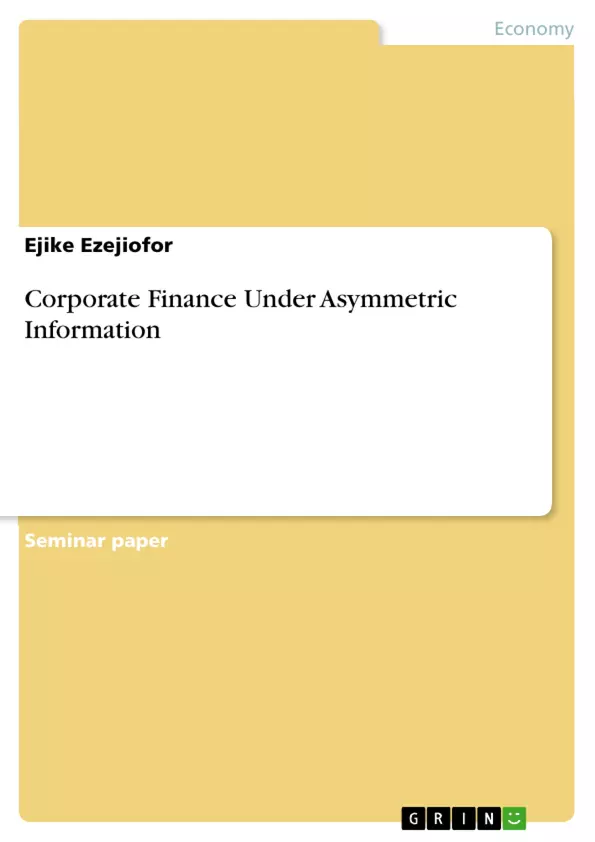The specter of decreased economic activities, financial crisis, unbecoming ethical standards have in the recent past and fore going, characterized asymmetric information on corporate finance. The consequences normally have a ricochet effect and can be generally catastrophic to normal economic activities to mention the least. This paper considers scenario’s where information asymmetry was prevalent or may have had its effects play out. The typical investor mindset and the opportunity cost associated with the preferred capital structure of the capitalizing process were mentioned.
A basis for proper appreciation of the concept – Corporate finance under asymmetric information was initiated here, with a detailed explanation of corporate finance and its components, this was succeeded by a summary of scenarios were asymmetric information were prevalent and an intelligent look was also taken at asymmetric information between insiders and investors and the concomitant lemon problem, where the effects were carefully highlighted in a progression to the level of severity - Market breakdown and costly signaling.
The fact that asymmetric information has been widely recognized as bad and generally viewed in a negative light must warrant it being viewed with a high level of seriousness. It is widely known that while lot of effort have been put into stemming the tides of the consequences of asymmetric information, a lot of effort too, have been dedicated to innovation and risk assessment, to capture the interest of investors, who have been affected by the consequences of asymmetric information. These may have formed a veritable platform for a recent paper by Pierre Barbaroux (2014), that elucidated the rise of innovation and innovative entrepreneurs based on the management of asymmetric information. An attempt has in any case, been made here to suggest efforts at marginalizing the negative impacts of asymmetric information and also remedies at reducing the far reaching impacts on the lenders and the aggregate economic activity in general.
Inhaltsverzeichnis (Table of Contents)
- ABSTRACT
- CORPORATE FINANCE
- CORPORATE FINANCE UNDER ASYMMETRIC INFORMATION
- CONSEQUENCES OF FINANCIAL DECISIONS WERE ASYMMETRIC INFORMATION EXISTS ARE LISTED AS THUS
- ASYMMETRIC INFORMATION BETWEEN INSIDERS AND INVESTORS AND THE CONCOMITANT LEMON PROBLEM
- MARKET BREAKDOWN AND COSTLY SIGNALING
- SUMMARY
- REFERENCES
Zielsetzung und Themenschwerpunkte (Objectives and Key Themes)
This paper aims to provide a comprehensive understanding of corporate finance in the context of asymmetric information. It examines the consequences of information asymmetry on financial decisions, exploring the impact on both investors and companies.
- The adverse effects of asymmetric information on corporate finance
- The “lemon problem” and its implications for investors
- Strategies for mitigating information asymmetry and its consequences
- The role of innovation in addressing information asymmetry
- Internal funding as a strategy to address asymmetric information
Zusammenfassung der Kapitel (Chapter Summaries)
- ABSTRACT: This chapter provides an overview of the paper, highlighting the importance of understanding asymmetric information in corporate finance and its impact on economic activities.
- CORPORATE FINANCE: This chapter defines corporate finance and its components, including equity and debt financing. It discusses the role of corporate finance in maximizing shareholder value.
- CORPORATE FINANCE UNDER ASYMMETRIC INFORMATION: This chapter explores the concept of asymmetric information in corporate finance and its implications for investors and companies. It delves into the "lemon problem" and its implications for market breakdown and costly signaling.
Schlüsselwörter (Keywords)
The primary focus of this paper is on asymmetric information in corporate finance. Key terms and concepts include information asymmetry, lemon problem, market breakdown, costly signaling, risk, innovation, internal funding, and financial decisions.
- Quote paper
- Ejike Ezejiofor (Author), 2014, Corporate Finance Under Asymmetric Information, Munich, GRIN Verlag, https://www.grin.com/document/283840



